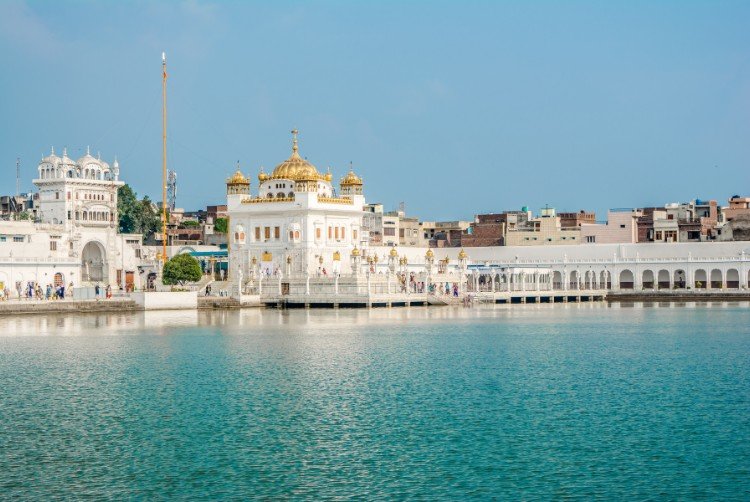A Sanctuary of Serenity and Spiritual Solace. A gleaming marvel of Sikh architecture, reflecting the rich tapestry of faith and unity amidst tranquil waters.
Welcome to the Golden Temple, the illustrious heart of Sikhism nestled in Amritsar, India.
Imagine a place where serene waters meet golden hues, creating not just a sight to behold but a journey of spiritual awakening.
This temple is more than an architectural masterpiece; it’s a symbol of equality, a beacon of hope, and a testament to the unwavering faith of millions.


Open all year round, 24 hours a day.
All visitors are required to cover their heads and wear modest attire as a sign of respect.
Early morning or late evening for a mesmerizing view of the temple illuminated against the night sky. November to March offers pleasant weather for visitors.

Site of the 1919 Amritsar massacre, a poignant memorial with preserved historical marks.

A majestic gurdwara founded by Guru Arjan Dev Ji, known for its large sacred pond.

Striking bronze statue of the legendary Sikh leader in the heart of Amritsar.
Upper floors are covered in almost 500 kg of pure gold.
Known as Harmandir Sahib, meaning "abode of God."
The temple welcomes all people.

Serves free meals to over 100,000 people daily.
Surrounded by a sacred pool known as the Amrit Sarovar.
Founded in the 16th century by the fifth Sikh Guru, Guru Arjan.





The Golden Temple, also known as Harmandir Sahib, stands as a testament to divine grace and the indomitable spirit of the Sikh people.
Each corner of this sacred site tells a story of faith, sacrifice, and miracles, weaving a rich tapestry of history that continues to inspire millions around the world.

In a remarkable demonstration of interfaith harmony, the foundation of the Golden Temple was laid by Hazrat Mian Mir, a revered Muslim Sufi saint, in 1589.
This act symbolizes the Sikh ethos of universal brotherhood and acceptance, highlighting the temple's welcoming nature to people of all faiths.

Established by Guru Hargobind Sahib, the sixth Sikh Guru, the Akal Takht (meaning "Throne of the Timeless One") stands opposite the Golden Temple.
It represents the temporal authority of Sikhism and has been a pivotal site for justice and political assembly, illustrating the religion's unique blend of spiritual and temporal leadership.

In June 1984, the Golden Temple witnessed one of the most tragic events in its history—Operation Blue Star.
This military action, aimed at removing armed insurgents, led to significant damage to the temple complex and a deep scar in the Sikh community's heart.
The event is remembered as a time of immense suffering and resilience.

The Golden Temple is home to the world's largest free kitchen, or Langar, serving meals to tens of thousands of people daily, regardless of race, religion, or social status.
This practice embodies the Sikh principle of Seva (selfless service) and the belief in the equality of all human beings.

In the early 19th century, Maharaja Ranjit Singh, the leader of the Sikh Empire, took a keen interest in refurbishing the Golden Temple, adorning its exterior with gold leaf and marble, which led to its moniker, the Golden Temple.
His devotion to the temple reflects the deep connection between Sikhism and its most revered shrine.

Adjacent to the Golden Temple, Jallianwala Bagh is a solemn reminder of the struggle for India's independence.
The massacre of hundreds of unarmed civilians by British forces in 1919 galvanized the Indian independence movement, with the Golden Temple playing a central role in rallying the people.

The Golden Temple is the spiritual home of the Guru Granth Sahib, the Sikh holy scripture, treated with the utmost reverence.
Installed in 1604 by Guru Arjan, the fifth Sikh Guru, it is considered the eternal Guru of Sikhism, embodying the religion's teachings and guiding the faithful.

The Golden Temple's architecture, with its unique blend of Hindu and Islamic designs, symbolizes the Sikh ideology of inclusivity.
Its lower marble level and gold-encased upper level, surrounded by the sacred Amrit Sarovar (Pool of Nectar), create a visual metaphor for the unity of God and humanity.

Several ancient Ber trees within the temple complex are associated with miraculous events and the lives of the Sikh Gurus.
These trees are not merely botanical specimens but revered symbols of the temple's spiritual heritage and the miraculous events witnessed by its walls.

Through centuries of history, the Golden Temple has stood as a beacon of hope, resilience, and unwavering faith.
Its stories of miracles, martyrdom, and unity continue to inspire and guide the Sikh community and visitors from around the globe, making it a true sanctuary for the soul.

The concept of the Golden Temple is envisioned by Guru Ram Das, the fourth Sikh Guru, who initiates the excavation of the holy tank (Amritsar or Amrit Sarovar).

Guru Arjan, the fifth Sikh Guru, lays the foundation stone of the Golden Temple with the assistance of Hazrat Mian Mir, a Muslim Sufi saint, illustrating the Sikh ethos of religious harmony and inclusivity.

Guru Arjan, the fifth Sikh Guru, lays the foundation stone of the Golden Temple with the assistance of Hazrat Mian Mir, a Muslim Sufi saint, illustrating the Sikh ethos of religious harmony and inclusivity.

The Guru Granth Sahib, Sikhism’s holy scripture, is installed in the Golden Temple by Guru Arjan. This event marks the site as the spiritual nucleus of the Sikh faith.

The temple faces destruction from Mughal and Afghan invaders, leading to a period of rebuilding and restoration under the Sikh community’s resilient spirit.

The temple faces destruction from Mughal and Afghan invaders, leading to a period of rebuilding and restoration under the Sikh community’s resilient spirit.

Maharaja Ranjit Singh, the leader of the Sikh Empire, takes control of Amritsar and pledges to restore and embellish the Golden Temple, marking a new era of prosperity for the shrine.

The Golden Temple’s sanctum is covered in gold leaf by Maharaja Ranjit Singh, giving it the iconic appearance and name by which it is known today.

The Golden Temple’s sanctum is covered in gold leaf by Maharaja Ranjit Singh, giving it the iconic appearance and name by which it is known today.

The Jallianwala Bagh Massacre, in close proximity to the Golden Temple, becomes a pivotal event in India’s struggle for independence, highlighting the temple’s significance as a center of spiritual and national consciousness.

The Golden Temple enters a tumultuous period during the Punjab insurgency, culminating in Operation Blue Star in 1984, causing significant damage to the temple complex and straining Sikh-community relations with the Indian government.

The Golden Temple enters a tumultuous period during the Punjab insurgency, culminating in Operation Blue Star in 1984, causing significant damage to the temple complex and straining Sikh-community relations with the Indian government.

Reconstruction efforts begin immediately after Operation Bluestar, reflecting the community’s resilience and dedication to their sacred shrine. The temple is restored to its former glory, reinforcing its status as a symbol of unwavering faith and perseverance.

The Golden Temple remains a major pilgrimage site, attracting millions of visitors from around the world each year. It continues to embody the principles of Sikhism, including equality, service, and devotion.

The Golden Temple remains a major pilgrimage site, attracting millions of visitors from around the world each year. It continues to embody the principles of Sikhism, including equality, service, and devotion.

The establishment of the Khalsa Heritage Memorial Complex, later known as the Virasat-e-Khalsa, near the Golden Temple, to commemorate 300 years of the Khalsa and to educate visitors about Sikh history and the significance of the temple.

The Punjab government launches a beautification and expansion project around the Golden Temple, enhancing the pilgrim experience and further integrating the temple with the city’s cultural and urban fabric.

The Punjab government launches a beautification and expansion project around the Golden Temple, enhancing the pilgrim experience and further integrating the temple with the city’s cultural and urban fabric.

The Golden Temple adapts to modern challenges, including health and safety measures during global events, while continuing to serve as a beacon of hope, peace, and spiritual sanctuary for all who visit.


The dawn of the Golden Temple, also known as Harmandir Sahib, heralded an era of spiritual enlightenment and architectural magnificence.
Conceived in divine inspiration, its foundation stone was laid by Guru Arjan, the fifth Sikh Guru, with the assistance of Hazrat Mian Mir, a Muslim saint.
This interfaith collaboration underscored the temple’s universal welcome, embodying a sanctuary where all souls could converge in search of divine truth and peace.
As the temple rose from the sacred waters of the Amrit Sarovar, its construction became a labor of love and devotion for the Sikh community.
Crafted with unparalleled skill, the temple was not merely a structure of wood and stone but a testament to the harmonious blend of various architectural styles, symbolizing the inclusive spirit of Sikhism.

Central to the temple’s ethos is the Langar, a communal kitchen that embodies the Sikh principle of selfless service and equality.
Initiated by Guru Nanak, the founder of Sikhism, the Langar serves free meals to all, regardless of background, faith, or social status.
This tradition has flourished within the temple’s precincts, offering sustenance and solidarity, and reinforcing the Golden Temple’s role as a beacon of communal harmony and spiritual nourishment.

The temple has witnessed periods of desecration and restoration, echoing the tumultuous history of the Sikh community itself.
Perhaps the most notable patron of its renaissance was Maharaja Ranjit Singh, who in the early 19th century adorned the temple with its iconic gold façade, transforming it into the resplendent Golden Temple.
This period marked a reinvigoration of the temple’s architectural and spiritual grandeur, symbolizing a new chapter in Sikh resilience and pride.

The Golden Temple has been a witness to both profound spiritual gatherings and harrowing conflicts, notably during Operation Blue Star in 1984.
This event marked a dark chapter in its history, yet the temple’s sanctity and significance to the Sikh faith remained unshaken.
It continues to stand as a symbol of the Sikh community’s unyielding faith and enduring strength in the face of adversity.

The temple’s architecture is a visual sermon in itself, with every motif, carving, and gilded panel narrating tales of divine love, cosmic order, and the unity of creation.
The intricate marble inlays, frescoes, and golden panels not only adorn its physical structure but also illustrate the spiritual beauty of Sikhism.
Artists and craftsmen over the centuries have contributed to its beauty, making the Golden Temple a living museum of Sikh art and heritage.

The daily rituals and annual celebrations at the Golden Temple, from the melodious recitations of Gurbani to the vibrant festivities of Vaisakhi, imbue the sacred precincts with a palpable sense of divinity.
These ceremonies are not just religious observances but a collective expression of joy, gratitude, and communal bonding, attracting devotees and admirers from across the globe.

The temple’s unique architectural design, featuring four entrances from all four directions, symbolizes openness and acceptance, inviting all to seek spiritual solace within its walls.
The harmonious interplay of light and water around the central sanctum, reflecting the ethereal golden glow, creates an atmosphere of celestial tranquility, inviting contemplation and connection with the Divine.

In recent years, the Golden Temple has embraced environmental sustainability and social welfare initiatives, reflecting the Sikh commitment to Sarbat da Bhala (welfare of all).
Efforts such as organic farming, solar energy utilization, and cleanliness campaigns around the temple precincts exemplify the integration of spiritual devotion with practical action towards global well-being.
The Golden Temple’s history is a mosaic of faith, courage, and compassion. It stands not just as a physical edifice but as a spiritual compass guiding humanity towards the virtues of love, equality, and selfless service.
Through centuries of celebration and sorrow, the Golden Temple remains a sanctuary of serenity and a testament to the eternal light of Sikhism.
Contact Us
Copyright © 2025 Temples.org. All rights reserved.